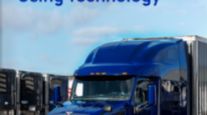Software Systems Help Warehouses, Carriers Move Freight Quickly, Accurately, Users Say
This story appears in the Sept. 17 print edition of Transport Topics.
Where warehouse dockworkers once had to go to a supervisor’s window for their assignments, advanced software has eliminated this and other long-standing procedures — turning the process of managing distribution centers into a faster, better-coordinated system, users and vendors said.
Eric Pocius, dock operations manager for the Custom Cos., Northlake, Ill., said that before his company began using dock-management software at its distribution centers, each dockworker would be given a handwritten manifest telling him which trailer a shipment was in and where it had to go. When that assignment was finished, the worker would return to the supervisor’s window for another assignment, and so on throughout a shift.
“If you’ve got 18 guys or 30 guys . . . at any given time, you could have them backed up, waiting,” Pocius said.
The basics of all dock-management systems are similar in that they use bar codes to identify and manage shipments. Dockworkers use handheld computers — such as personal digital assistants (PDAs) — with laser bar-code readers, or they use touch screens equipped with readers that can be mounted on forklifts. Wi-Fi coverage of the dock enables the exchange of data between the dockworkers’ devices and the dock-management system.
“We can operate much faster, much more efficiently,” Pocius said of the system provided by Carrier Logistics Inc., Tarrytown, N.Y. “An operator can finish one job and go on to the next. These small things add up over time and make a big difference.”
Other companies offering dock-management systems are McLeod Software, Birmingham, Ala., and TMW Systems Inc., Cleveland.
Vendors said their systems are designed to work with a range of devices for dockworkers, including units manufactured by Honeywell International, Morristown, N.J.; Intermec Inc., Everett, Wash.; and Motorola Solutions Inc., Schaumburg, Ill., which makes Symbol devices.
The dock-management system enables the company to send four or five assignments to the worker’s handheld and arrange for their prioritization.
When there are exceptions for damage or a shortage, the dockworker can indicate that on the handheld unit, which recognizes the exception and “locks up” until a supervisor arrives to enter a code that returns it to operating mode, Pocius said. This is a way of ensuring that the supervisor is made aware of the exception.
There are fewer incidents of shipments being placed on the wrong trailer, Pocius added, attributing the decrease to the fact that each bar-coded shipment is designated for loading at a door that is also identified by a bar code. If a dockworker mistakenly goes to the wrong door and tries to scan, say, a New Jersey shipment onto a California-bound load, the scanner will lock, pending the supervisor’s intervention.
Such moments also offer opportunities for training or troubleshooting, Pocius said.
“Maybe it wasn’t the loader’s fault,” he said. “Maybe [the shipment] was mismarked on the breaking side or maybe by the shipper.”
The time savings provided by the dock-management software helps the Custom Cos. fulfill delivery guarantees, Pocius said.
For example, if a “hot shipment” is missing from a trailer, the system will not register a dockworker’s efforts to enter that the trailer load is complete, he said. If the shipment cannot be placed onboard, for whatever reason, a supervisor’s explanation is required before the trailer can be recorded as loaded, Pocius said.
Marc Mitchell, vice president of less-than-truckload technologies for McLeod, said the dock-management software could lead to offering new services or better levels of service such as picking up later into the afternoon and delivering earlier in the morning.
Because dock-management systems automate routine exchanges of essential information — identification of shipments, up-to-the-moment detail on where shipments are and where they should be moved to — they help accelerate freight handling, vendors and users said.
“That’s where dock-scanning capability can help in a pure operational sense,” Mitchell said.
Depending on the information technology vendor and the carrier’s IT setup, dock-management software could be part of an enterprisewide system that incorporates dispatch planning and other functions — or it might be a stand-alone program. In either case, the dock-management component would be integrated with the carrier’s mobile communications so that when a truck is coming in for unloading, “dockworkers already know what orders are on it,” said Sean Jennings, software solutions engineer for TMW Systems.
Victor Jensch Sr. of Rosenau Transport Ltd., Edmonton, Alberta, said the ability to track, monitor and manage shipments with a dock-management system begins with bar codes attached to shipments by drivers at pickup. Stickers bearing the same bar code are fixed onto the shipment and two copies of the bill of lading — one for the carrier and one for the shipper.
The driver transmits the bar-code number to dispatch, where it is linked to the data stored from the shipper’s original call requesting pickup. A freight number, or PRO (progressive routing order) bill, is generated and linked to the bar-code number. The bar-code number is the PRO-bill number, so data are automatically linked from pickup to dock management system, through to delivery. This enables identification, tracking and management of the shipment, Jensch said.
Rosenau Transport, which has 22 terminals in western Canada, uses CLI’s dock-management system integrated with route-optimizing dispatch software provided by Cheetah Software Systems, Westlake Village, Calif. The carrier has a subsidiary — K&K Forwarding Ltd., Sparwood, British Columbia — whose operations reach into the United States, Jensch said.
N&M Transfer Co., Neenah, Wis., a regional LTL carrier that operates in its home state and in Illinois, Iowa and Minnesota, implemented the McLeod module for dock management “to increase the speed of their turn overnight at the dock — so the trucks can arrive later than they used to and get out earlier in the morning,” Mitchell said.
Providing additional services to shippers is another way to make the systems pay off, Mitchell said, adding that most LTL terminals are busy from late afternoon until about 6 a.m.
“From 9 till 5, it’s a boring place to be. It’s an asset that’s not generating revenue for the company that owns it,” he said.
Mitchell said some carriers, with the help of the dock-management software, use the space to store or manage inventory for customers. He said a carrier could accumulate freight and convert it into larger-lot or truckload shipments for a better rate.
Ben Wiesen, vice president of product and services for CLI, said, “Every trucking company that has a dock is operating a short-term warehouse. . . . Sometimes, it’s only [for] two hours, between one truck and another.”
If storage time mounts up, however, carriers can find themselves doing free warehousing, Wiesen said.
A dock-management system can capture information about it and turn a “free” service into something a carrier is compensated for, Wiesen said.
“Their tariffs and rules typically allow for them to charge the customer for storage,” Wiesen said, “but their computerized procedures — or lack of computerized procedures — don’t accommodate it, so it never happens.”
While dock-management software is designed to help distribution centers load and unload trucks more quickly and with fewer mistakes — and also help them and freight carriers fulfill promises of guaranteed delivery — users and vendors said the technology may not be good for everyone, and carriers should carefully study the potential returns because the technology requires a substantial investment.
One thing potential buyers should consider is using the technology to add profitable services, such as storing and managing a customer’s inventory or consolidating shipments, vendors said.
Considering the cost to deploy the technology, carriers that make the investment “need to work harder to find the [return on investment],” said McLeod’s Mitchell.
Kenneth Weinberg, vice president of CLI, advised: “Spread the cost out on a daily basis and compare that to your return — what you get in benefits.”
That analysis, he said, should show whether the investment is worthwhile.




